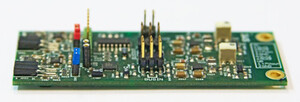
Silicon photo multiplier - SiPM
SiPMs are novel solid state based low level light detectors, providing unique features in terms of single photon detection, very high quantum efficiency, outstanding time resolution and much higher gain compared to APDs.
SiPMs are used already for several photon detector applications at SMI (e.g. Hbar-Hodoscope, VIP-2 veto counters, R&D work for PANDA-SciTile and Cherenkov-TOF-PET).
Assembling of the Hbar-Hodoscope, consisting of two scintillation layers, each with 32 stripes read out on both sides with SiPMs.

As Silicon photomultipliers are offered by many vendors differ in many parameters such as cell capacitance and photon detection efficiency which influences the time resolution of the devices. Although, SiPM are used for many timing applications, no systematic measurements for comparison of the time resolution of SiPM have been published, so far. Therefore, a semi-automatic stand including a pico-second laser and waveform sampling for characterisation of the time resolution has been set up and allows measurements at various temperature and voltage conditions. So far devices of AdvanSiD, Ketek and Hamamatsu have been tested and first results already have been published. Furthermore, the time resolutions of the Philips digital SiPM (digital photon counter) has been determined using a slightly different setup (due to the already implemented electronics).
Scintillator tiles (SciTil) are planned to be used for fast time-of-flight detectors for PANDA. The presence of a large magnetic field due a solenoid magnet prohibits the use of PMTs. At SMI a prototype of a scintillating tile with SiPM readout was investigated and it was demonstrated to provide a time resolution below 100 ps.
Two identical scintillator tiles have been used to estimate the time resolution of a single tile by using the time-of-flight (TOF) resolution:


Gaseous detectors - Gem technology electronics

The Gas Electron Multiplier (GEM) detector has been introduced by Fabio Sauli in 1997. Characterized by high rate capability and position accuracy, flexibility in shape and lightness, the detector has been successively developed by many research groups, used as tracker and fast triggering system in particle and nuclear physics experiments. The future applications of such a very promising technology require for large area covering with full efficiency, low material budget and high spatial resolution, together with a new simplified and cost effective detector design, which will allow to reduce as much as possible the assembly time and will be suitable for mass production.

Large Time Projection Chamber (TPC)
A GEM-TPC with more than 10.000 channels has been built and implemented in the FOPI spectrometer at GSI-Helmholtzzentrum, Germany, where the GEM-TPC was used during a 3-week physics campaign to study pion-induced reactions on different nuclear targets. The GEM-TPC significantly improved the vertex processing selection capability of the experiment, and provided particle identification via the measurement of the specific energy loss. This is the first application of such a device in a physics experiment.
The idea of an un-gated, continuously running TPC is of interest, for example for the upgrade of the TPC for ALICE, is only possible due to one of the key features of a GEM-TPC, the excellent ion backflow suppression.
The closed cycle gas system has been developed at SMI.

Active target TPC
Simulation and design studies using hydrogen as counter gas in a TPC with GARFIELD and GEANT programmes have been performed in order to investigate the use of such an active target TPC-GEM for example as inner tracker for the AMADEUS experiment at DAFNE. A prototype has been designed and is under construction, which will allow first test measurements with pure gases like helium and hydrogen.

Electronics

Intelligent Frontend Electronics for Silicon (IFES) board for SiPM detectors
(Patent application in progress)
We redesign and improve our frontend electronics for silicon photomultipliers. The newly developed IFES (Intelligent Frontend Electronics for Silicon photo detectors) modules combine an easy to use pre-amplifier with remote control over the amplification gain with an onboard discriminator that provides a time over threshold (ToT) signal and a full differential signal way.
The differential signal is generated at the active detector and amplified by an 2.2 GHz differential amplifier, the resulting signal is split into a small fraction that is fed to an leading edge discriminator that provides energy information encoded as length of the digital pulse. The other part of the signal is provided to the user in form of a differential analogue signal. The digital ToT signal is provided as a LVDS (Low Voltage Digital Signal) pulse. The main advantages of using a fully differential signal way is that the noise pickup on long signal lines is suppressed and that the connection itself is ground free. In big experiments earth loops introduce lots of noise pickup which is usually a big problem. The design of the new modules helps circumventing the grounding problem.
The IFES modules can be remotely controlled by a computer, the control bus is an SPI interface driven by LVDS. Therefore even small low-cost microcomputers as an Arduino are capable of controlling the modules and therefore providing and easy to use end user interface that can be integrated into various slow-control and DAQ systems.